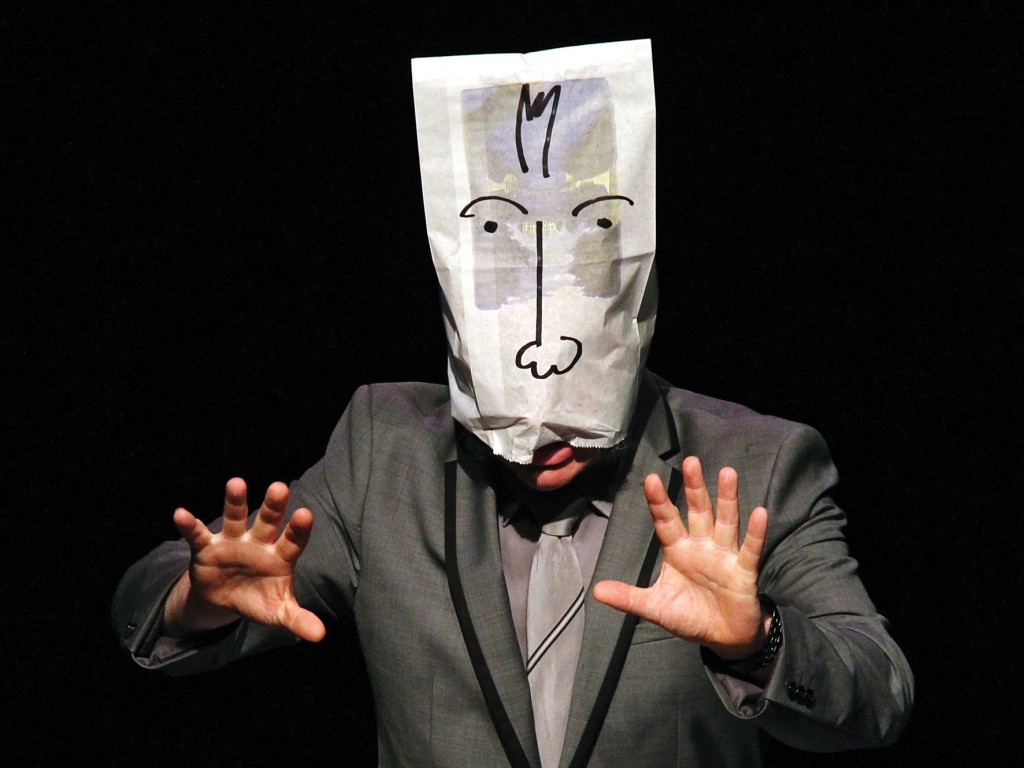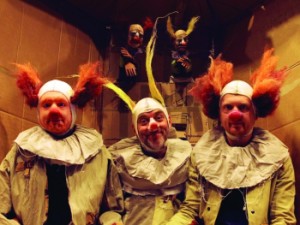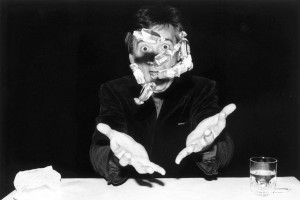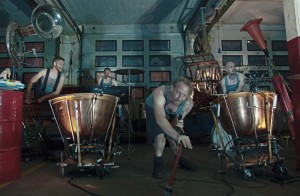 L’HOMME CONTENT DE RIEN at the Tobacco Factory on 4th September
L’HOMME CONTENT DE RIEN at the Tobacco Factory on 4th September
Bristol Festival of Puppetry is Puppet Place’s flagship event. For two weeks at the end of the summer it welcomes artists from all over the world, runs workshops in everything from stop-frame animation to object theatre and parades giant puppets through the streets in the popular Community Carnival. Puppet Place is dedicated to bringing the best of puppetry from around the world to Bristol and showcasing the wealth of talent in the South West.
REVIEWS
COULROPHOBIA on 28th August at the Tobacco Factory
 The show starts with the usual kids stuff of clowns with boxes and balloons, inquisitive and surprised at the unfolding world, but soon slides into a dark and silly world into which the audience is lured in with ne’re a ‘by your leave’.
The show starts with the usual kids stuff of clowns with boxes and balloons, inquisitive and surprised at the unfolding world, but soon slides into a dark and silly world into which the audience is lured in with ne’re a ‘by your leave’.
Two clowns, Adam and Dick, (living, breathing people) are trapped in a mutually abusive relationship in a cardboard world, waiting for release, with malice aforethought, puppets of a demonic presence that is revealed as a ‘real’ puppet, Uncle Bocca; a malign invention who can out-Punch Punch in wanton cruelty.
A phobia, as we know, is an irrational or extreme fear of something, but these two clowns engender quite the opposite. Such is their invention and brio we can only delight in the absurd, slapstick violence. Picture Eddie and Richie from Bottom, gaily beating seven shades out of each other by way of releasing the frustration of their situation. The only way out is by getting their clown clothes onto members of the audience – leaving them stark naked and free.
The show’s invention never sags, but frolics in a childlike capacity of immersion in the imaginative moment. It is brilliant, often hilarious entertainment the like of which you won’t have seen before. Graham Wyles
SMALL SUICIDES: Three Brief Exorcisms of Quotidian Use on 29th August at the Tobacco Factory
 Carles Cañellas, with longish, wavy hair, dark shirt, tweed jacket and looking vaguely professorial, explains that he is the keeper of a cherished theatrical jewel. ‘Object theatre’, as the name suggests, uses everyday (‘quotidian’) objects, undisguised or transformed (save by our imaginations) in any way in order to tell a story or take part in some esoteric theatrical poetry. Like a man who has rediscovered the key to childhood and is anxious to pass on the secret, he slips into an inchoate language (think of Morph) in which he plays out the inevitable fate of an Alka-Seltzer tablet in a land of wrapped sweets. With such a small cast each thing is treated with care, indeed respect, during which a three way relationship emerges between presenter’s imagination, object and audience.
Carles Cañellas, with longish, wavy hair, dark shirt, tweed jacket and looking vaguely professorial, explains that he is the keeper of a cherished theatrical jewel. ‘Object theatre’, as the name suggests, uses everyday (‘quotidian’) objects, undisguised or transformed (save by our imaginations) in any way in order to tell a story or take part in some esoteric theatrical poetry. Like a man who has rediscovered the key to childhood and is anxious to pass on the secret, he slips into an inchoate language (think of Morph) in which he plays out the inevitable fate of an Alka-Seltzer tablet in a land of wrapped sweets. With such a small cast each thing is treated with care, indeed respect, during which a three way relationship emerges between presenter’s imagination, object and audience.
A second scenario tells of the love of a Swedish match for a Brazilian coffee bean whilst a third is a contemplation on time and possibly entropy, involving a Japanese garden made of coffee in which something appearing to be shaving cream and, more annoyingly, foam, makes a continual unwelcome appearance.
Nothing is played for laughs – which would be childish – but everything is done with wit, the effect of which is child-like. Each object becomes potential protagonist in a limitless possibility of scenarios, which leaves our imaginations re-charged with wonder. Graham Wyles
RAMKOERS (Collision Course) on 30th August at the Arnolfini
 It’s usually pretty obvious when you are listening to music, even if a particular form is unfamiliar. What is increasingly less obvious is the form of the instrument that makes the music, which could indeed be no more than a computer. Dutch group, Bot have taken the view that the physical thing that makes the music can be as much a part of the fun and enjoyment as the music itself.
It’s usually pretty obvious when you are listening to music, even if a particular form is unfamiliar. What is increasingly less obvious is the form of the instrument that makes the music, which could indeed be no more than a computer. Dutch group, Bot have taken the view that the physical thing that makes the music can be as much a part of the fun and enjoyment as the music itself.
Imagine that William Heath Robinson had a mad nephew who decided to use his uncle’s drawings as blueprints for a mechanical punk band. Then suppose said nephew formed an act in which it appeared that a bunch of anarchic roadies had taken over the show after a night on some pretty mind expanding drugs and in which the living, breathing contraption-cum-instruments were dragged onto the stage (or in the case of a weirdly autonomous accordion, dragged itself), part constructed only to be assembled before your very eyes. An electric saw, a rhythm section that defies description, screaming wood, a man in a can, a hand playing a child’s toy piano, exploding clogs, a man in a rotating piano (think Leonardo’s Vitruvian Man) rolling onto the stage, quivering cow bells and much, much else.
The music, pulsating in-your-face rock, which can collapse into delicate melody played on a bicycle-pump organ or foot operated harmonium with lyrics (mostly in Dutch) occasionally with vibrato to the human voice supplied by a salad spinner. It’s the theatre of stuff. Incredible, fantastic. This was their first outing in the UK, but If they don’t rapidly find their way onto a Glastonbury stage I’ll be most surprised. Graham Wyles
WUNDERKAMMER on 31st August at the Tobacco Factory
 Out of this extraordinarily moody production oozed something quite retro but at the same time something madly new – a steampunk essay on wires if you like.
Out of this extraordinarily moody production oozed something quite retro but at the same time something madly new – a steampunk essay on wires if you like.
Puppeteers Alice-Therese Gottschalk, Raphael Mürle and Frank Soehnle, who all studied under German master puppeteer Albrecht Roser at the Figurentheaterschule Stuttgart, a school for puppetry at the Conservatory for Music and the Dramatic Arts, where he was professor and head of the department, have brought their own strange dream-like visions to the puppetry genre. In ten dark but witty and mesmerizing cameos, they dipped into boxes and caskets, breathing life into entrancing and sometimes sinister characters, against an atmospheric musical score by jazz pianist Michael Wollney and harpsichord player Tamar Halperin, with electronic music and custom-written pieces for cello written by Bradley Kemp.
Wunderkammer, or in English, Cabinet of Curiosities, was just that. Looking a cross between a patchwork doll and an extra out of Star Wars, Gottschalk sat and unpeeled her gripped-up hair before opening the first box lid of the night. A pair of golden hands flickered into life and crept spider-like up her arms and teased her hair with long fingertips. Were they some extension of her desires, or her torments? Were they controlling her or vice versa? Were they evil or benign? The simple choreography let our minds wander like the hands. In the darkness puppeteer and props asked us questions of ourselves.
On through the cabinet we went. A strange see-through sea-creature that looked like it had escaped from the deepest ocean rose from its tank, its manipulator looking every bit the mad scientist. A weird worm-like man rose from a chrysalis-like construction, odd faces with long arms and spindly fingers hovered and danced across coloured panels. The curiosities kept coming.
There were some delightful uses of simple materials for maximum effect. In one scene a little man rode upon a cloud of white tissue paper. The cloud suddenly took on a figurative form and began a ghostly pas-de-deux before finally collapsing as a cloud of confetti. You begin to get the idea. There is wit here, perhaps also a sense of longing or loss amongst these devices. As the light went down after each weird interlude you began to wonder what might be next. The audience seemed quite hypnotised.
Wunderkammer represents one big tick for the enchantment of low-tech, and is yet more proof if it be needed that puppetry can go where mainstream acting cannot – taking flight into the fragile nature of a truly surreal world. Simon Bishop
L’HOMME CONTENT DE RIEN at the Tobacco Factory on 4th September by La Compagnie des Chemins de Terre
A jovial undertaker, Rene, struggles, partly perhaps through nerves, to contain his ebullient nature whilst addressing the audience who stand in as the relatives of a deceased man killed in some kind of accident. Before him, a banquet set out for the wake is covered by a cloth which, when drawn over the feast, becomes a shroud covering the body. It is the first of the transformations that structure this cunning piece of object theatre.
As an accomplished mime artist and street performer in his native Belgium, Stéphane Georis has that wonderful ability to draw solid shapes out of thin air and the wit to turn the most unlikely object into a story telling character. I struggle to recall exactly how it happened other than that it was a story told by a philosophy teacher, but we found ourselves witnessing Adam and Eve, two rolled up pieces of cheese (from Aldi) who were being deprived of the delights of the Garden of Eden by a wrathful and possessive God – played convincingly by a sheet of tin foil which pounced on and gobbled up anything that took their fancy. Other witnesses to the accident were given voice by the contents of the table in a series of unlikely and surprising cameos.
The apparent chaos was all carefully choreographed as the cleverly transformed objects took us on a journey into a highly original world. Graham Wyles

